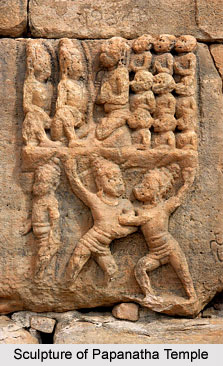 Sculpture of Papanatha temple depicts the richness in architecture and frescoes and main entrance faces the eastern direction. The garbhagriha of the main shrine is surrounded by pradakshinapatha while the three walls have devakoshtha pavilions. On the other hand the Ardha-Mandpa, Sabha-Mandapa and an entrance porch have been provided with kakshasana. Another unusual feature of this temple is that the Nandi temple is missing. In its place a well sculpted image of Nandi has been placed on the eastern part of the Sabha-Mandapa.
Sculpture of Papanatha temple depicts the richness in architecture and frescoes and main entrance faces the eastern direction. The garbhagriha of the main shrine is surrounded by pradakshinapatha while the three walls have devakoshtha pavilions. On the other hand the Ardha-Mandpa, Sabha-Mandapa and an entrance porch have been provided with kakshasana. Another unusual feature of this temple is that the Nandi temple is missing. In its place a well sculpted image of Nandi has been placed on the eastern part of the Sabha-Mandapa.
The temple building is built on a plinth that has five mouldings. It has also been profusely decorated with floral sculptures, animal motifs and kudus. The sculpture of Papanatha temple also comprises the popular perforated windows. The niches in the walls have been filled up with the sculpted figures of Shaiva, Vasihnava deities and tales from Ramayana. On the top of these nooks one will come across chaitya-arch motifs and the perforated windows. Another striking feature of the sculpture of Papanatha temple is the rekha nagara shikhara that lies on the northern side. It has been decorated with a well sculpted chaitya arch that houses the image of Nataraja. The regular elements like the kalasa and the amalaka are missing.
The narrative panel consists of incidents from Ramayana and Kiratarjuniya have been sculpted on stone. What is noteworthy here is that the names of the characters have also been etched out along with the characters. The sculptures of Baladeva, Devaraya, Changama, Revadi, Ovajja and others are to be found with the figures. Such details make the sculpture of Papanatha temple worth exploring.
Pillars constitute an integral part of temple architecture. The pillars standing on the porch of this Pattadakal temple have been decorated with Kinnara couples and the columns have the figures of the `dwarapalas`. The corners of the entablature bear the figures of lions and sardulas. On the other hand the ceiling panels of Papanatha temple have been decorated with dancing Shiva with Parvati and musicians and flying figures. Sculptures of damsels and couples have been used as embellishments for pillars and pilasters of the other mandapas sculpture. While Anantasayana surrounded by the Dikpalas, Nagaraja and Gajalakshmi adorns the bay ceiling of the sabha mandapa, the ceiling of the ardha mandapa has relief of dancing Lord Shiva and he is accompanied by his consort Parvati and musicians. Names of the main characters of the episodes like Baladeva, Devaraya, Changama, Revadi, Ovajja are found engraved in right places. Pillars of the entrance porch bear Kinnara couples and columns have the figures of Dvarapalas.
Another major feature of the sculpture of Papanatha temple is the well carved doorframes. Lions and sardulas are carved at the corners. The western ceiling here has figure of Nagaraja.



















